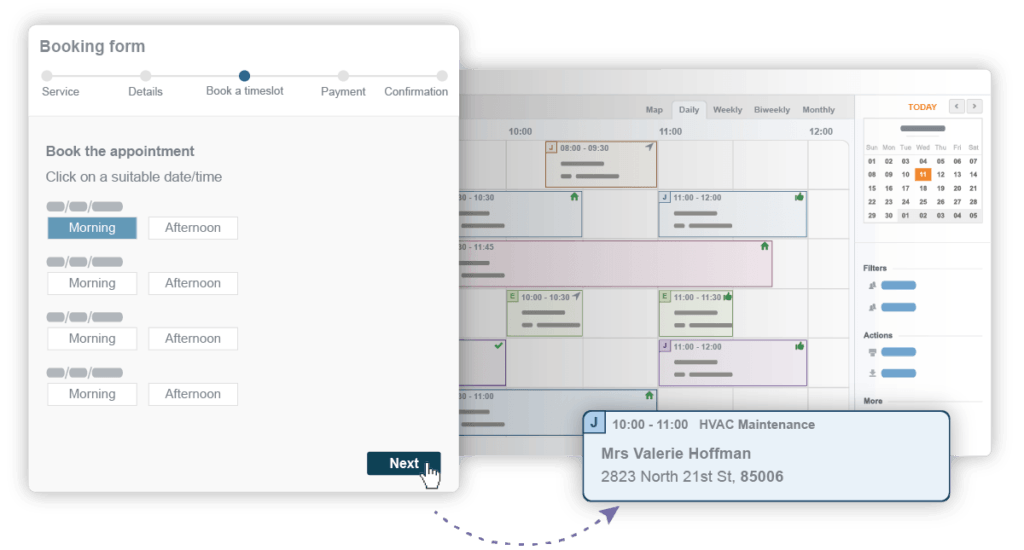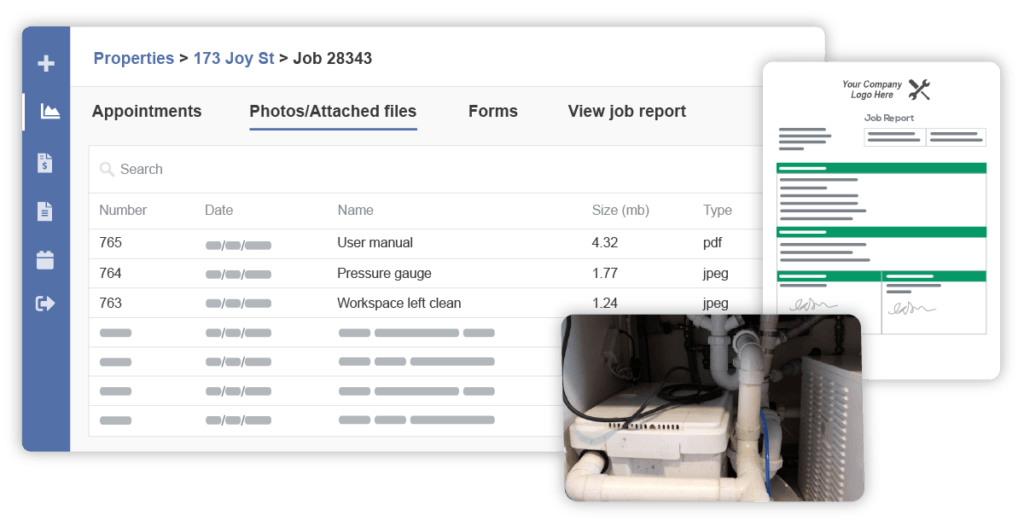How to Improve CX with Self-Service Solutions
May 22, 2023 | Read: 13 minutes

Improving the customer experience (CX) is becoming more of a top priority for businesses across the maintenance industry, and self-service solutions have emerged as an essential tool in achieving this goal.
Self-service solutions are technologies and platforms that empower customers to find information, complete transactions, and resolve issues independently, without the need for direct assistance from a customer service representative.
By implementing effective self-service solutions, businesses can enhance the CX by providing customers with:
- Convenient ways to access real-time information.
- Multiple ways to interact with products or services.
- The ability to receive support whenever required.

What Are Self-Service Solutions?
Self-service solutions encompass a range of digital tools and technologies that enable customers to independently find information, perform tasks, and resolve issues.
These solutions can take various forms, including:
- Appointment booking portals – That’s your classic calendar view of available appointment slots; ideal for residential customers.
- Technician route tracking tools – A map view showing where the technician is located once they’re on their way.
- Invoicing portals – A screen where customers can see their invoices and job breakdown.
- Online payment portal – A tool for customers to pay directly from their invoice, online.
- Service reminder booking – A booking screen specifically designed for booking routine maintenance services.
- After-sales care – A feedback portal giving customers a chance to share their experiences directly with you, before they do this publicly on your Google profile.
- Customer login portals and mobile apps – For commercial customers with multiple properties, a broader customer portal may be required. Once logged in, customers can access properties, jobs, invoices, certificates and more.
- Knowledge bases/Help Centre – A knowledge repository for your customers to help them deal with frequently encountered problems.
- FAQs – These are frequently asked questions about your business. You can take the questions your admins hear most often and add them here to preempt customers wasting time on the phone.
- Chatbots – Initially chatbots were designed to mimic conversations with real people, but nowadays they’re mostly used outside of working hours to help customers navigate FAQ and record their information (email, phone number, etc.) so that an agent can contact them the next day.
You can implement these self-service features individually, by looking for dedicated companies selling each tool.
However, since they usually require a lot of customer data to work properly, the ideal way is to have your job management software provide them as existing features or integrations.
Through these platforms, current and potential clients can access an abundance of information, make purchases, track orders, troubleshoot issues, and even connect with customer support agents if necessary.
The Role of Self-Service in the Customer Experience
Customer self-service software plays a crucial role in shaping the overall customer experience. It provides customers with the flexibility and convenience they seek while allowing them to engage with your services where and when they want to.
By offering self-service options, companies demonstrate their commitment to customer empowerment and convenience. Self-service solutions can significantly reduce wait times and enable customers to find information quickly, book effortlessly, and resolve issues without lengthy interactions that take up your customer services department’s time.
Self-service options are available around the clock, making sure that customers can access support or the resources they need at any time. This can quickly increase customer satisfaction and loyalty without increasing your costs.
Importance of CX in the Trade Service Industry
In the trade service industry, companies often do work that involves repairs and installations and a smooth and effortless customer experience is crucial for success.
Customers in this world often require prompt or sometimes emergency service, and any delays or frustrations can lead to dissatisfaction, breach of service level agreements, and worst case scenario, a potential loss of business.
Implementing self-service solutions results in streamlining the customer journey, enabling customers to schedule appointments, track progress, and receive updates in real time.
By offering self-service options such as online booking systems or their own customer screen (for your larger commercial clients), businesses can provide a seamless and convenient experience that meets customer expectations, improving customer satisfaction and increasing loyalty.
Six Benefits of Customer Self-Service Solutions
1. Improved Accessibility and Convenience for Customers
Customers like doing things themselves, if possible and, ideally, comfortable. It’s a matter of feeling in control. You’re basically outsourcing tasks to your customers and improving their experience at the same time. Double win for you, right?
Customer self-service solutions offer the advantage of improved accessibility and convenience for customers. By providing self-service options, businesses empower customers to find answers to their questions or resolve issues on their own.
Booking-related tools like appointment calendars, service reminders, re-booking, and customer login screens are essential for any service business looking to offer customers the option of managing their appointments anytime they want and without having to call in.
Remember, most people these days hate calling!
2. Increased Efficiency for the Business
Implementing self-service applications allows companies to find new ways to increase efficiency.
By enabling customers to handle routine tasks independently (such as updating account information or tracking appointments or their technicians), employees can focus their efforts on more complex issues.
This shift in workload reduces the burden on your technicians and office staff, freeing up valuable time and resources that can be used to provide personalized support or take on new and challenging customer inquiries.
3. Reduced Workload for Staff
One of the key benefits of customer self-service solutions is the reduced workload for every department. By empowering customers to access information without the need for a support team, self-service options lead to a faster resolution of issues.
When customers can find answers on their own, the workload on your business decreases significantly. As a result, employees can manage their responsibilities more effectively, contributing to a more streamlined customer service process overall.
This contributes to increased staff wellbeing, as they can focus on more complex tasks that engage their skills to a higher level. Ask your admin how much more they’d enjoy the work if they didn’t have to stop every other minute to answer the phone and let people know that “Yes, the appointment really is on Monday. This Monday. Not last Monday.”
If you’re struggling with retention in general, self-service solutions can make a difference.
4. Cost Savings
Customer self-service solutions also provide cost-cutting opportunities for businesses. By reducing the need for extensive support departments, companies can allocate their budgets more efficiently and invest in training current staff to handle more complex tasks (which, again, helps with retention).
With self-service options in place, customers can handle simple inquiries and tasks independently, minimizing the need for your staff to constantly deal with small, repetitive queries..
This not only reduces labor costs but shows businesses how they can optimize their resources, funneling them toward jobs that need additional attention.
5. Greater Flexibility
24/7 availability is a tall order even for the larger service companies. It’s not realistic to keep an overnight support department if it doesn’t make business sense.
Another notable benefit of customer self-service solutions is the ability to offer this flexibility. By offering customers 24/7 access to support and services, businesses cater to their needs at any time, regardless of time zones or operating hours.
This round-the-clock availability enhances customer satisfaction, as they can interact with the company at their own convenience.
Whether it’s seeking information or placing work orders, customers can engage with self-service options whenever they prefer, fostering a positive customer experience.
6. Improved Data Collection
How can you fix something if you don’t know where the problem is? This is why collecting with custom forms is important if you want to grow sustainably. It will highlight the areas where you’re doing a good job and help you understand where you can improve.
Implementing customer self-service solutions can significantly enhance a company’s ability to collect valuable data on customer behavior, preferences, and needs.
By tracking customer interactions and patterns within self-service platforms, businesses gain insights into how customers engage with your services.
This data can be leveraged to refine and improve the customer experience and personalize future interactions. By analyzing the information gathered within the self-service environment, companies can make data-driven decisions that better align with customer expectations and drive overall business growth.
Seven Ways to Improve Your Customer Experience with Self-Service Solutions
1. Offer Online Appointment Scheduling
Offering automated online appointment scheduling provides customers with a convenient option, particularly if they have busy schedules.
By allowing customers to book appointments on their own time, businesses streamline the scheduling process and reduce the likelihood of double bookings.
This self-service solution enhances the overall customer experience by providing flexibility and ease of use.

2. Provide Access to Customer Accounts with Self-Service Portals
By offering self-service tech, businesses create a centralized location where customers can access their account information, view past orders or appointments, and communicate with the company’s team.
This not only enhances the customer experience but also gives customers more control and visibility over their interactions with the business.
Self-service portals empower customers to manage their accounts independently, saving time and increasing customer satisfaction.
3. Create a Knowledge Base and FAQ Page
Developing a comprehensive knowledge base with FAQ resources provides customers with easy access to answers to common questions or concerns.
By providing troubleshooting guides, FAQ pages, and other helpful resources, businesses can save customers time and frustration.
Additionally, these self-service resources help reduce the workload for customer service representatives by addressing commonly encountered issues, allowing them to focus on time-consuming inquiries.
4. Implement Mobile Self-Service Solutions
As more customers lean towards using their mobile devices for everyday life, providing mobile self-service solutions is crucial.
A customer portal software that they can access on the go can provide customers with the convenience of accessing services and information whenever and wherever they are.
This self-service option enhances the customer experience by providing a seamless and user-friendly interface that aligns with the preferences of customers who primarily operate using mobile devices.

5. Utilize Chatbots for Customer Service
Chatbots are automated tools that provide immediate assistance to customers, helping them find answers to common questions or directing them to the appropriate support channel.
By leveraging chatbots, businesses can:
- Offer 24/7 support, which improves the customer experience by providing immediate assistance and reducing wait times.
- Handle routine inquiries – freeing up human agents to focus on more complex customer interactions.
6. Enable Online Payment Processing
Enabling online payment processing simplifies invoicing for customers and reduces the risk of errors. It offers a more convenient option for customers who prefer to pay online or who are unable to visit the business’s physical location.
Most management software will offer these in the form of integrations with payment providers, so make sure to check what your current software has.
In case you’re reviewing software options, this is an important question to ask first.
By incorporating secure and user-friendly online payment solutions, businesses enhance the customer experience by providing a smooth and efficient transaction process.
7. Provide Real-Time Status Updates
Keeping customers informed about the status of their service requests in real-time is essential for building trust and confidence in a business.
Real-time status updates are useful because they:
- Help customers track the progress of their requests without the need to call in for updates.
- Improve the customer experience by offering transparent and timely information.
- Reduce unnecessary customer inquiries – leading to more time for your administration team and office tasks.
Self-Service Solutions Best Practices
Identify Customer Pain Points
To effectively implement self-service solutions, it is crucial to identify customer pain points. Put yourself in their shoes: What would you consider a high-quality service?
By understanding the challenges customers encounter when seeking assistance or information, businesses can tailor their self-service options to address those specific pain points.
Conducting customer surveys, analyzing feedback, and monitoring support interactions can provide valuable insights into areas where self-service can be most beneficial.
Make the Interface User-Friendly
User-friendliness is a major aspect of successful self-service solutions. It is essential to find a software provider that has thought out the end customers’ experience.
Clear instructions, well-organized information, and new features can enhance the user experience, enabling customers to quickly find what they need and easily accomplish their tasks.
Easy-to-navigate interfaces that cater to users of varying technical abilities will make the difference when it comes to loyalty and satisfaction.
Offer Multiple Channels
Providing multiple channels for self-service options ensures that customers can engage with the business in their preferred manner.
While some customers may prefer a knowledge base or FAQ section on the website, others may find chatbots or mobile apps more convenient.
By offering a range of self-service channels, businesses cater to different customer preferences, increasing the likelihood of adoption and customer satisfaction.
Provide Self-Service Options Throughout the Customer Journey
Effective self-service solutions should be available at every stage of the customer journey.
From pre-purchase research to post-purchase support, customers should have access to relevant self-service resources.
By providing self-service options throughout the entire customer journey, businesses empower customers to find answers and resolve issues independently, creating a unique and rewarding experience.
Use Data and Analytics
Data and analytics play a crucial role in optimizing self-service solutions.
By analyzing customer interactions, businesses can gain insights into patterns, popular searches, and areas where self-service options may fall short.
This information can help refine and improve self-service resources, ensuring they align with customer needs and preferences.
Ensure Seamless Integration
Seamless integration of self-service solutions with existing systems and platforms is essential for a five-star customer experience.
The self-service options should either be a part of your job management software or integrate with it smoothly.
This will help to reduce friction and avoid customer frustration.
Provide Support When Needed
While the goal of self-service is to empower customers to find solutions on their own, there will be instances where human support is necessary.
It’s best practice to offer clear pathways for customers to seek assistance when the self-service options are insufficient or when they prefer human intervention.
Providing easy access to live chat, email support, or phone assistance ensures that customers can seamlessly transition from self-service to personal support when needed, enhancing the overall customer experience.
Start Providing a Better Customer Experience for Your Trade Business Today!
If you’re been trying to think of new ways to provide your clients with the experience they’ve always dreamed of, customer self-service software like Commusoft could be the solution your business is looking for.
It covers the portals highlighted above and integrates them in the overall job management software, making it easy for your team to operate smoothly.
Don’t fall behind the competition and start providing a better and personalized customer journey for your trade business, today!
Click the banner below to learn about customer self-service software!

Cristina Maria
I'm here to bring you next-level strategies to the field service industry. When I'm not working on the best tips to grow your business, I'm on the lookout for sci-fi novels and cookie recipes.








